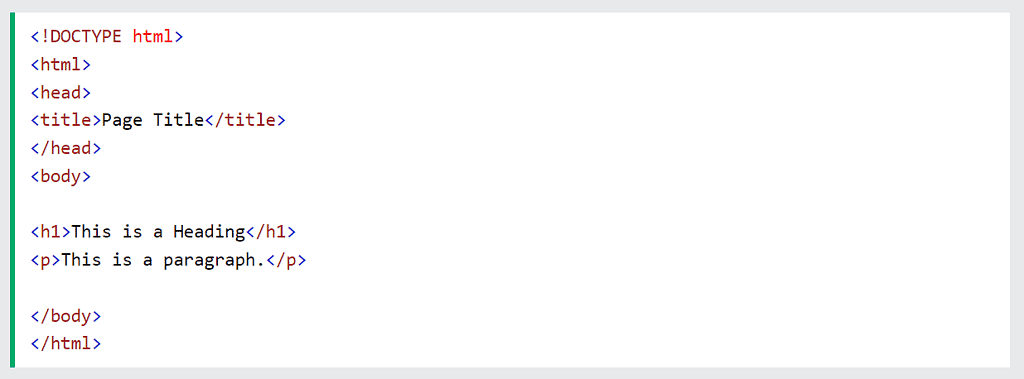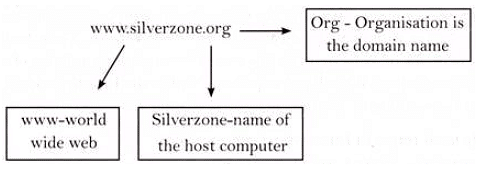Detailed Notes: Internet (Part - 1) | Computer - Class 5 PDF Download
Important Terms
www (World Wide Web):
The www is a collection of electronic documents (called web pages) that are linked together like a spider web.

Hyperlink:
- It is an element in an electronic document that links to another place in the same document or an entirely different document, or another resource.
- Hyperlinks usually appear as underlined text and in a different color, but they may also appear as graphics, such as buttons to click.
- Hyperlinks may be used to link another place in the same place, or another page, to play an audio or video file, to download file, to set up a message to an e-mail address, and to link to other Internet resources.
For example https://edurev.in/courses/16193_Compter-Science-for-Class-5
Web Page:
- A web page is an electronic document written in a computer language called HTML (Hyper Text Markup Language).
- Web pages can contain text, graphics, video, animation, and sound, as well as interactive features such as data entry forms.
- Web pages usually contain hyperlinks to other web pages.

Web Site:
A website is one or more web pages belonging to a particular company, institute, government, or individual, the first page is called the Home page, which acts like an index, indicating the content on the site.

URL (Uniform Resource Locator):
Every page on the web has a unique address, called a uniform Resources locator (URL). A URL indicates where the web pages are stored on the internet.

Internet Address
- Addresses are just what they sound like a way to identify a unique area of the Net or an individual on the Net.
- For example, if someone wants to send you something, such as an e-mail, they must know your address. If someone wants to retrieve something from a computer on the internet, they must know the Domain name or the IP address of the computer

Some Domain Name List

Some Geographic Domain

Use of Internet
Some Domain Name List

Some Geographic Domain

Use of Internet
Some Domain Name List

Some Geographic Domain

Use of Internet
- We can send birthday greeting cards through the internet.
- We can earn online by doing freelancing jobs, selling online, completing surveys, etc.
- We can sell old items that are of no use to us.
- It contains a huge amount of information on different fields.
- Internet is an entertainment hub.
- The Internet also provides e-business which can also enhance business.
- We can listen to music, watch movies or play video games on it.
- The students can get the academic information they require.
- We can read online news websites.
Hardware and Software Requirements for the Internet
The hardware and software needed for connecting to the internet will involve five basic items:
- Computer.
- Modem.
- An internet connection.
- Cable for connecting the modem to the internet connection.
- Special software.
The required hardware and software will vary depending on the type of Internet connection that you have selected. Before you start, you should check with your local Internet Service Provider (ISP) to make sure your equipment will work with their services.
Internet Connection
- Internet Connections is given by Internet Service Provider (ISP).
- An ISP is an Internet Service Provider, a company that you pay to provide you with a connection to the internet.
- An ISP gives us an Account name and Password that we can use to connect to the internet.
Some of the ISPs in India are:
- Airtel
- Jio
- MTNL (Mahanagar Telephone Nigam Limited)
- Sify
- Tata Indicom Broadband
There are several ways to connect to the internet. All require a modem:
- DSL: A Digital Service Loop connects your computer to the internet via a faster method of dial-up.
- Cable: Cable Companies often offer high-speed access along with cable TV Cable internet is a shared connection to the internet with the rest of your neighborhood. The more people have cable internet, the more potential for slower access.
- Wireless/Wi-Fi: Uses a receiver to connect your computer to the internet without any wires. Among other places, libraries, some hotels, and coffee shops offer wireless access to people who bring their laptops.
Starting the Internet
The step to start the Internet on your computer is very simple.
- If your computer is permanently connected to the Net, double-click on the Microsoft Edge icon on the desktop, which comes by default in Windows 10. Follow the sequence, Start à All App à Microsoft Edge.
- If your computer is not permanently connected to the Net, you need to dial up a connection to your access provider's computer.
If you want to check your computer is connected to the Net. For this, perform the following steps:
- Under the Start button option, select Windows settings options.
- Under the Windows setting option, select the "Network & Internet" option.
- Double click on "Internet Option" and click on "Change adapter options".
- After clicking on "Change adapter options," a Network connections Window will appear, which shows the current or available connection on the system.
- If the net is connected properly, you see the images as shown:

If your net is not connected permanently, you need to use the IP address:
For this, perform the following steps:
1. Under the Start button option, select the Windows setting option.
2. Under the Windows Setting option, select the "Network & Internet" option.
3. Double click on "Internet option" and click on "change adapter options".
4. After clicking on "change adapter options," you reached "Network Connection" Windows.
5. Here, you see the Ethernet option right, click on it and select the Properties option under the right-click contextual menu.
6. Double click on "Internet Protocol version 4 (TCP/IPv4) under the Ethernet Properties.
7. Click on the "Use the following IP address" Now fill in the required detail which you have:
An IP address is a unique address that identifies a device on the internet or a local network. An IPv4 address consists of four sets of numbers from 0 to 255, separated by dots.
For example, "76.34.41.89".
Subnet Mask: A subnet mask is a number that defines a range of IP addresses that can be used in a network.
Default gateway: A default gateway is used to allow devices in one network to communicate with devices in another network.
After clicking these details click on Ok.
World Wide Web Surfing
- The world wide web (www) can be viewed as a huge distributed system consisting of millions of clients and servers for accessing linked documents servers maintain collections of documents, while clients provide users an easy-to-use interface for presenting and accessing those documents.
- The basis of the www was developed at CERN (The European Laboratory For Particle Physics) in Switzerland by Tim Berners-Lee and co-workers.
- Once we are connected to the Internet, we can surf the Internet by default using Microsoft Edge and other commonly used browser is Google Chrome.
|
33 videos|30 docs|32 tests
|
FAQs on Detailed Notes: Internet (Part - 1) - Computer - Class 5
| 1. What is the Internet? |  |
| 2. How does the Internet work? |  |
| 3. What are the benefits of using the Internet? |  |
| 4. How can I stay safe while using the Internet? |  |
| 5. How has the Internet transformed various industries? |  |

|
Explore Courses for Class 5 exam
|

|





















